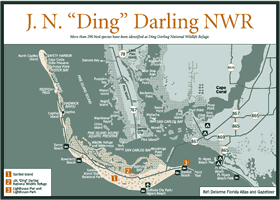
[Fig. 21 (2)] Tucked away amid condominiums and the busy beaches of Sanibel Island, the J. N. "Ding" Darling National Wildlife Refuge is a small, but wildlife-laden area that offers some of the best opportunities in Florida to see wading birds. The 5,220-acre refuge, established in 1945, is largely composed of mangrove estuaries and mud flats. Located along the Atlantic Flyway, the refuge serves as a permanent and seasonal residence for more than 290 bird species, some visiting from as far away as the Arctic Circle.
The big attraction is the appropriately named Wildlife Drive, a 5-mile, unpaved
but smooth gravel road that winds through the mangroves into the heart of the
refuge. Before taking the drive, be sure to pick up a copy of the Wildlife
Drive Guide at the visitor center. Plan to take your time and pull over often.
You'll discover one scenic view after another of open mud flats and busy wildlife.
Sometimes the longer you stay at a spot the more you'll see.
Information signs and a bird viewing tower enhance the drive. Along Alligator Curve, alligators sometimes sun themselves along the banks. At another spot you'll see double-crested cormorants and Anhingas swimming and feeding in the clear water. Anhingas spear their prey on their sharp bills and cormorants simply grab their prospective meal.
From the tower you might spot a flock of roseate spoonbills, which are in their brightest plumage between January and March. Mangrove cuckoos, ospreys, red-shouldered hawks, bald eagles, brown pelicans, and common moorhens reside at the refuge year-round and are often seen along the drive.
On any of the shallow flats look for the bluish-colored reddish egret. These dainty wading birds spread their wings to cast a shadow over the water so they can see their prey as they run after it. Other common wading birds in the refuge include great egrets, white ibis, yellow-crowned night herons, and great blue herons.
Scanning the clear waters, you might also see a blue crab walking sideways along the muddy bottom. Although too large to eat, it still gives the birds a wide berth. Raccoons can also be seen snooping carefully along the base of the mangrove trees, searching through the exposed roots for tasty morsels.
Interconnected walking trails lead to other observation points. The Shell Mound Trail winds through tangled vegetation to an ancient Calusa Indian shell mound. Tram tours and guided canoeing and kayak trips are also available during some seasons.
For the best wildlife viewing opportunities plan your trip for low tide when wading birds will be feeding. In the warm months plan your drive for early in the morning or late in the afternoon. In winter, migrating visitors like white pelicans and red-breasted mergansers (Mergus serrator) can be spotted.
The refuge was named for J. N. "Ding" Darling, an esteemed political cartoonist and lifelong conservationist. Born in Norwood, Michigan, in 1876, Darling was a two-time Pulitzer Prize-winning cartoonist whose political cartoons appeared in 130 daily newspapers. In Florida he was also known for focusing national attention on the plight of Florida's Key deer with a cartoon that depicted the end of the "toy deer." In 1934, Henry A. Wallace, Franklin Roosevelt's secretary of agriculture, appointed Darling chief of the biological survey (later to become the U.S. Fish and Wildlife Service). As one of his obligations, Darling agreed to do the artwork for the first Duck Stamp.
When Franklin Delano Roosevelt called the first North American Wildlife Conference in 1936, 1,500 conservationists attended. They adopted the constitution for the General Wildlife Federation and elected Darling the first president. This group's name was officially changed to National Wildlife Federation in 1938.
There's a replica of Darling's studio at the visitor center. On the last weekend of January the center celebrates J. N. "Ding" Darling's birthday.
There's also a brief orientation film shown every half hour at the visitor center. Particularly interesting is the refuge time line tracing the area from prehistory to 1978.
Carry insect repellant year-round for mosquitos and no-see-ums. In the summer expect high temperatures and high humidity. Picnicking and camping are not allowed in the refuge. Naturalist presentations and guided tours are mostly available during the winter months. Binoculars and spotting scopes are highly recommended.